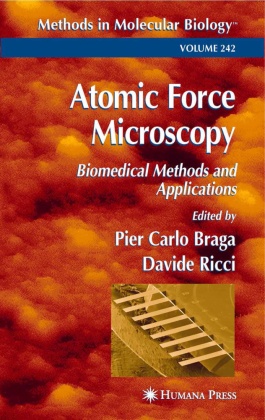Atomic Force Microscopy - Biomedical Methods and Applications
| Verlag | Springer |
| Auflage | 2003 |
| Seiten | 394 |
| Format | 23,5 cm |
| Gewicht | 1660 g |
| Artikeltyp | Englisches Buch |
| Reihe | Methods in Molecular Biology 242 |
| EAN | 9781588290946 |
| Bestell-Nr | 58829094UA |
The natural, biological, medical, and related sciences would not be what they are today without the microscope. After the introduction of the optical microscope, a second breakthrough in morphostructural surface analysis occurred in the 1940s with the development of the scanning electron microscope (SEM), which, instead of light (i. e. , photons) and glass lenses, uses electrons and electromagnetic lenses (magnetic coils). Optical and scanning (or transmission) electron microscopes are called "far-field microscopes" because of the long distance between the sample and the point at which the image is obtained in comparison with the wavelengths of the photons or electrons involved. In this case, the image is a diffraction pattern and its resolution is wavelength limited. In 1986, a completely new type of microscopy was proposed, which, without the use of lenses, photons, or electrons, directly explores the sample surface by means of mechanical scanning, thus opening up unexpected pos sibilities for the morphostructural and mechanical analysis of biological specimens. These new scanning probe microscopes are based on the concept of near-field microscopy, which overcomes the problem of the limited diffraction-related resolution inherent in conventional microscopes. Located in the immediate vicinity of the sample itself (usually within a few nanometers), the probe records the intensity, rather than the interference signal, thus significantly improving resolution. Since the most we- known microscopes of this type operate using atomic forces, they are frequently referred to as atomic force microscopes (AFMs).
Inhaltsverzeichnis:
The Basics of Atomic Force Microscopy.- How the Atomic Force Microscope Works.- Imaging Methods in Atomic Force Microscopy.- Recognizing and Avoiding Artifacts in AFM Imaging.- Advanced Biosensing Using Micromechanical Cantilever Arrays.- Morphostructural Analysis of Cellular Structures.- Analysis of Human Fibroblasts by Atomic Force Microscopy.- Corneal Tissue Observed by Atomic Force Microscopy.- AFM Study of Surface Structure Changes in Mouse Spermatozoa Associated With Maturation.- Calculation of Cuticle Step Heights from AFM Images of Outer Surfaces of Human Hair.- Imaging Living Chondrocyte Surface Structures With AFM Contact Mode.- Growth Cones of Living Neurons Probed by Atomic Force Microscopy.- Evaluating Demineralization and Mechanical Properties of Human Dentin With AFM.- Applying Atomic Force Microscopy to Studies in Cardiac Physiology.- Imaging Bacterial Shape, Surface, and Appendages Before and After Treatments With Antibiotics.- Subcellular Structures Investigation .- Visualizing Nuclear Structure In Situ by Atomic Force Microscopy.- Imaging Surface and Submembranous Structures in Living Cells With the Atomic Force Microscope.- Atomic Force Microscopy of Protein Complexes.- Atomic Force Microscopy of Interfacial Monomolecular Films of Pulmonary Surfactant.- High-Resolution Analysis of the 3D Organization of Human Metaphase Chromosomes.- Shape and Volume of Living Aldosterone-Sensitive Cells Imaged with the Atomic Force Microscope.- Localization of Epithelial Sodium Channels by Atomic Force Microscopy.- High-Resolution Imaging of Bacteriorhodopsin by Atomic Force Microscopy.- Functional Investigations with AFM.- Measurement of Mechanical Properties of Intact Endothelial Cells in Fresh Arteries.- Observation of Oxidative Stress on Yeast Cells.- Lymphoblastoid Cells Exposed to Low-Frequency Magnetic Fields.- Sample Preparation Method for Observing RNA Polymerase Activity by Atomic Force Microscopy.- Atomic Force Microscopy of ?-Amyloid.- How to Build Up Biosensors With the Cantilever of the Atomic Force Microscope.- Measurement of Single Molecular Interactions by Dynamic Force Microscopy.

